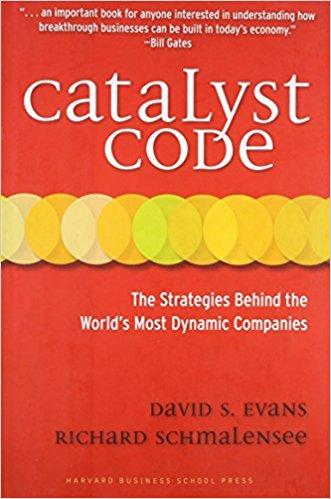Catalyst Code Summary

3 min read ⌚
 The Strategies Behind the World’s Most Dynamic Companies
The Strategies Behind the World’s Most Dynamic Companies
“Catalyst Code” teaches you how you can create sales by connecting buyers and sellers who were not previously linked.
About David S. Evans and Richard Schmalensee
 David S. Evans is a visiting professor at University College in London and vice chairman of an international consulting company
David S. Evans is a visiting professor at University College in London and vice chairman of an international consulting company
Richard Schmalensee is dean of Sloan School of Management at MIT.
“Catalyst Code Summary”
In the past, entrepreneurs have followed a business model which was one-sided. In other words, consumers, when they entered the store, they bought products with little interest in how and where the product was produced.
However, nowadays, things are different.
Today, businesses use the “catalyst” model, which is multisided.
What are catalysts?
In chemistry, catalysts create a reaction between two substances.
Following this analogy, in terms of commerce, catalysts create sales among sellers and buyers who were not connected previously and had no way of connecting.
Now, you may be confused because it is easy to envision every business out there as a catalyst. However, that is not the case.
For example, as the supermarket is not a catalyst for the wholesalers and the shoppers are not working together – they have the supermarket as a middleman with whom they do business.
In other words, a catalyst is a direct link between parties who work together.
Okay, now that we have cleared this out, we will give you six steps to being a successful catalyst:
- Figure Out Who You’re Going to Serve
Target your audience, get to know them and find out their needs, and choose your business model.
- Analyze “why and how much they need each other”
- Analyze other players in the market
- Decide whether a “multi-sided” or “one-sided” model works best
- Set Prices
Although this is a tricky step, there are a few guidelines that can make it easier for you:
- Establish separate prices for access and usage
- Let price balance demand
- Set prices for modest growth
- It might make sense to pay customers to belong
- Maximize long-term profits
- Structure for Success
Think of your groups’ needs and set up a platform where they can meet and satisfy them.
- Encourage groups to interact
- Cut transaction costs
- “Design for evolution.”
- Think Profits
Know the history, but focus on the future.
- “Study industry history.”
- Predict the future
- Think like a chess player
- Compete Strategically with Other Catalysts
Manage your expectations and do not expect complete loyalty from customers.
- Anticipate unexpected rivalries
- “Leverage to attack.”
- “Consider cooperation
- “Experiment and Evolve”
Know when it is time to be a market leader and when a follower.
-
- Control growth
-
- Offer something unique
-
- Plan for what’s next
- Look out for the cops
Key Lessons from “Catalyst Code”
1. The Three Activities of Catalysts
2. Types of Catalysts
3. Six Steps to Becoming a Successful Catalyst
The Three Activities of Catalysts
-
- Offer “a value proposition.”
-
- “Provide information.”
- “Make rules.”
Types of Catalysts
-
- “Matchmakers”
-
- “Audience builders.”
- “Cost minimizers.”
Six Steps to Becoming a Successful Catalyst
-
- Figure Out Who You’re Going to Serve
-
- Set Prices
-
- Structure for Success
-
- Think Profits
-
- Compete Strategically with Other Catalysts
- “Experiment and Evolve”
Like this summary? We’d Like to invite you to download our free 12 min app, for more amazing summaries and audiobooks.
“Catalyst Code” Quotes
A successful catalyst must find a way to win over both sides of the market more or less at once. Share on X Galleries are catalysts. They work hard to attract both sides to their platforms. Share on X Successful strategies are regularly imitated by enterprises that think they can execute them better. Share on X Catalysts must balance the short-run benefits of getting more interactions against the long-run costs of discouraging customers. Share on X Having seen your success, other entrepreneurs will build on what you have learned. Being first doesn’t guarantee success. Being paranoid helps. Share on X







